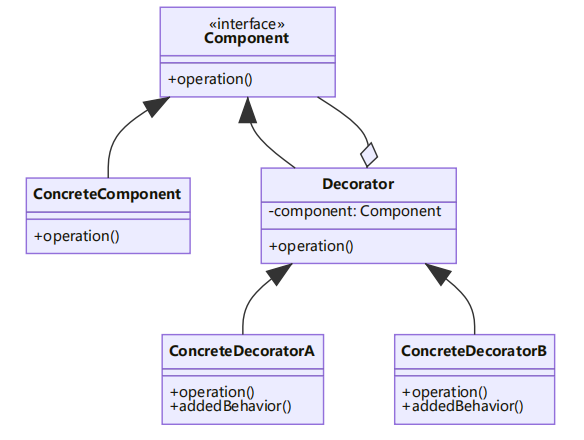10.设计模式-DECORATOR(装饰)
一、模式定义与核心思想
装饰器模式是一种结构型设计模式,其核心目标是通过动态包装对象的方式,在不修改原有类代码的前提下,灵活扩展对象的功能。该模式以“组合优于继承”为设计哲学,通过多层嵌套装饰器实现功能的按需叠加,完美解决以下问题:
- 动态扩展:运行时按需添加或移除功能(如为文本动态叠加加密、压缩等处理层)
- 避免继承爆炸:当存在多种功能组合时,无需为每个组合创建子类(如咖啡加料的N种组合场景)
- 职责解耦:将核心功能与附加功能分离(如日志记录、权限校验等横切关注点)
核心价值:
- 开闭原则:扩展开放,修改关闭
- 功能热插拔:支持运行时动态调整功能组合
- 复用性提升:每个装饰器仅关注单一功能增强
二、模式组成与UML类图
核心角色
- Component(抽象组件)
-
- 定义统一接口(如
Coffee接口的getCost()和getDescription())
- 定义统一接口(如
- ConcreteComponent(具体组件)
-
- 实现基础功能(如
SimpleCoffee提供基础咖啡)
- 实现基础功能(如
- Decorator(抽象装饰器)
-
- 持有组件引用,定义装饰逻辑(如
CoffeeDecorator基类)
- 持有组件引用,定义装饰逻辑(如
- ConcreteDecorator(具体装饰器)
-
- 实现具体扩展功能(如
MilkDecorator添加牛奶)
- 实现具体扩展功能(如
UML类图
classDiagram
class Component {
<<interface>>
+operation()
}
class ConcreteComponent {
+operation()
}
class Decorator {
-component: Component
+operation()
}
class ConcreteDecoratorA {
+operation()
+addedBehavior()
}
class ConcreteDecoratorB {
+operation()
+addedBehavior()
}
Component <|-- ConcreteComponent
Component <|-- Decorator
Decorator <|-- ConcreteDecoratorA
Decorator <|-- ConcreteDecoratorB
Decorator o-- Component

三、代码实现示例
场景:实现可定制化的咖啡加料系统
// 1. 抽象组件
interface Coffee {
double getCost();
String getDescription();
}
// 2. 具体组件
class SimpleCoffee implements Coffee {
public double getCost() { return 2.0; }
public String getDescription() { return "基础咖啡"; }
}
// 3. 抽象装饰器
abstract class CoffeeDecorator implements Coffee {
protected Coffee decoratedCoffee;
public CoffeeDecorator(Coffee coffee) {
this.decoratedCoffee = coffee;
}
}
// 4. 具体装饰器
class MilkDecorator extends CoffeeDecorator {
public MilkDecorator(Coffee coffee) { super(coffee); }
public double getCost() {
return super.decoratedCoffee.getCost() + 0.5;
}
public String getDescription() {
return super.decoratedCoffee.getDescription() + ", 加牛奶";
}
}
class CaramelDecorator extends CoffeeDecorator {
public CaramelDecorator(Coffee coffee) { super(coffee); }
public double getCost() {
return super.decoratedCoffee.getCost() + 1.0;
}
public String getDescription() {
return super.decoratedCoffee.getDescription() + ", 加焦糖";
}
}
// 5. 客户端调用
public class Client {
public static void main(String[] args) {
Coffee coffee = new SimpleCoffee();
coffee = new MilkDecorator(coffee);
coffee = new CaramelDecorator(coffee);
System.out.println(coffee.getDescription());
// 输出:基础咖啡, 加牛奶, 加焦糖
System.out.println(coffee.getCost());
// 输出:3.5
}
}
四、工业级源码应用
- Java I/O流体系(经典案例)
InputStream in = new BufferedInputStream( // 缓冲装饰器[10,11](@ref)
new GZIPInputStream( // 解压装饰器
new FileInputStream("data.gz"))); // 基础组件
- 设计解析:
FileInputStream作为具体组件,BufferedInputStream和GZIPInputStream作为装饰器,按需叠加功能
- Spring框架缓存管理
@Cacheable(value="users",
cacheManager="compositeCacheManager") // 组合多个缓存装饰器
public User getUser(Long id) {...}
- 通过
CompositeCacheManager整合Redis、Ehcache等不同缓存实现
- Android UI组件系统
View view = new ScrollViewDecorator( // 滚动条装饰器
new BorderDecorator( // 边框装饰器
new TextView())); // 基础组件
- 动态为UI控件添加滚动、阴影等视觉特效
- 游戏角色装备系统
Character warrior = new ArmorDecorator( // 护甲装饰器
new WeaponDecorator( // 武器装饰器
new BaseCharacter())); // 基础角色
- 动态叠加攻击力、防御力等属性加成
- MyBatis二级缓存
<cache type="org.mybatis.caches.redis.RedisCache">
<property name="eviction" value="LRU"/>
</cache>
- 通过
FifoCache、LruCache等装饰器扩展缓存策略
总结
装饰器模式如同软件世界的“俄罗斯套娃”,通过层层嵌套的包装机制,为系统功能的动态扩展提供了优雅的解决方案。其核心价值在Java I/O流体系、Spring框架等工业级系统中得到充分验证,成为应对需求变化的利器。掌握该模式的关键在于准确识别功能扩展维度,并通过合理的接口设计实现功能的热插拔组合



 浙公网安备 33010602011771号
浙公网安备 33010602011771号